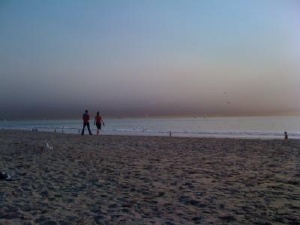Nov 20 2008
The health threat to city dwellers posed by Southern California wildfires like those of November 2008 may have been underestimated by officials.
 Smoke from wildfires on distant inland hills pours over the ocean at Venice Beach, Calif., Nov. 16. Credit: Viterbi School of Engineering
Smoke from wildfires on distant inland hills pours over the ocean at Venice Beach, Calif., Nov. 16. Credit: Viterbi School of Engineering
Detailed particulate analysis of the smoke produced by previous California wild fires indicates that the composition posed more serious potential threats to health than is generally realized, according to a new paper analyzing particulate matter (PM) from wildfires in Southern California.
The paper, entitled "Physicochemical and Toxicological Profile of Particulate Matter (PM) in Los Angeles during the October 2007 Southern California Wildfires," will appear in Environmental Science and Technology. It confirms earlier studies by air polllution specialist Constantinos Sioutas of the USC Viterbi School of Engineering, who is also co-director of the Southern California Particle Center.
For the study Sioutas and colleagues from USC, the University of Wisconsin-Madison and RIVM (the National Institute of Health and the Environment of the Netherlands) analyzed the particular matter gathered during the fall 2007 blazes.
"Fire emissions produce a significantly larger aerosol in size than typically seen in urban environments during periods affected by traffic sources, which emit mostly ultrafine particles," Sioutas said.
"Staying indoors may not provide protection from smoke particles in the absence of air conditioning or the ability to recirculate filtered indoor air. This is because the fire particles can penetrate indoor structures more readily than particles from vehicular emissions."
According to Sioutas, the fires produce a dangerous mix. "The chemical composition of particles during the fire episodes is different than that during 'normal' days impacted by traffic sources.
"Tracers of biomass burning (e.g. potassium and levoglucosan) were elevated by two-fold during the fire periodm" he said. "Water-soluble organic carbon (WSOC) was also higher during the fire event. This makes these particles from wood smoke more bioavailable, thus more readily absorbable by our system than particulate matter from traffic sources."
The ability of the particulates to penetrate structures, even if windows are closed, and their potential ability to be absorbed by human tissues are a matter of concern. "More aggressive measures to avoid smoke seem to deserve study, including distribution of masks and evacuation to air conditioned environments, and closure of non-smoke secured schools," said Sioutas, who holds the school's Fred Champion Professorship of Civil and Environmental Engineering.